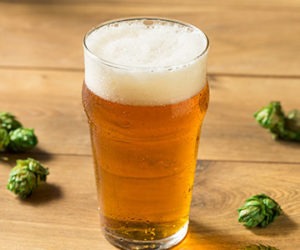Advancements in Dry Hopping
Research has changed the way we dry hop. Dry hopping has been a regular brewing technique for nearly two centuries. As you may know, around 1822 beer was first sent from England in wooden casks to the British army in India. The beer had recently been switched from a lower alcohol porter that was spoiling on the hot six-month sea journey, to a lighter colored, higher alcohol IPA believed to be around 6–7% ABV. The cask was stuffed with Goldings hops, the beer made it safe and sound, the British army was happy to have the unspoiled beer, and the rest is history. From that point on, Britain would send casks of beer to India stuffed with hops, up to around 10 lbs. (4.5 kg) per 31-gallon (117-L) barrel.
In the past two decades, India pale ale has become the calling card of the craft brewing industry. Not only as the fastest growing style of beer year over year, it now comes in as many varieties as possibly imaginable. American, English, black, white, session, double, red, . . . the list goes on and on.
Although IPA is not the only style that has utilized dry hopping, its popularity has led to the trend of dry hopping numerous other styles in breweries throughout the United States and world. Due to this technique’s popularity, much research has been done over the past decade. Assumptions have been proven wrong, processes have changed, and new information continues to flood industry conferences and periodicals.
Let’s take a look at some tips and techniques for dry hopping based on some of the newest research and information out there.
Tip #1: Dry hopping doesn’t increase foam or head retention, it decreases it.
Iso-alpha acids aid in head retention, but some of these compounds that stabilize your foam actually disappear when dry hopping because the plant material in hops actually absorbs iso-alpha acid. So, if you’re looking for stable foam on your beer, avoid too excessive, or too long of a dry hopping1.
It’s also been learned that if you dry hop aggressively enough there becomes a point where foam-positive alpha-acids are solubilized (these compounds are usually viewed as insoluble in wort and beer). At such a high dry-hopping level you will regain some head retention lost with the reduction in iso-alpha acids. You may also introduce a perceived harsh bitterness in your beer.
Takeaway #1: Iso-alpha acids decrease in beer when dry hopping, resulting in a decreased head retention. Based on the current research, assume that head retention will be affected to a greater extent if you use 1 ounce of dry hops or more per gallon (7 g per L) of beer.
Tip #2: Dry hopping will likely decrease bitterness in a highly hopped beer.
The concentration of iso-alpha acids in beer declines by 30–40% during the typical 3+ day dry hopping period. This happens because these surface-loving compounds adhere to the hop matter added during dry hopping and are removed from beer with the spent hops. Hops do contain humulinone from oxidized alpha acids, and humulinone is bitter, about 65% as much as iso-alpha acids. This means that the loss in iso-alpha acids during dry hopping is somewhat off-set by the gain in bitterness from humulinone2.
In a beer with low bitterness, humulinone could possibly add more bitterness than is lost in iso-alpha bitterness, creating more perceived bitterness in the beer. This is because there weren’t a lot of iso-alpha acids to begin with. Alpha acid also solubilizes during dry hopping, but to less of an extent than humulinone. It’s a bitter substance that can lessen the decrease in perceived bitterness if dry hopping in large quantities with a high alpha hop — say, more than 1 ounce per gallon (7 g per L) of beer2.
In highly hopped (during the boil) beers, the soluble humulinone replaces some of the stronger iso-alpha bitterness that was present, creating a perceived decrease in bitterness. If you think your beer tastes bitter, or would like to decrease bitterness, try dry hopping with a lower alpha acid hop (less than 10% AAU,) at about 1 ounce per gallon (7 g per L) for 3–5 days.
Tip #3: Hop aromas are synergistic. Using multiple varieties can create stronger aromatics than the same amount of a single variety.
In sensory tests, scientific panels have found the amount of hop oil in a hop didn’t actually tell you how much aroma a hop would provide. What they were able to determine though was that harvest time, oxygen presence, and hop oil combinations all have a much greater effect on aroma than once thought. The easiest of these areas for us to manipulate as brewers are the synergistic qualities.
Experiments were run by Ayako Sanekata of Frontier Laboratories for Sapporo beer on Sorachi Ace hops. Sorachi Ace, a hop high in geranic acid, when combined with a hop like EkuanotTM, a hop high in geranial and geraniol, exponentially increased aroma output. As explained by John Bryce of Lupulin Exchange, “1+1 doesn’t always equal 2, when talking about hop synergies, 1+1 can equal 11.”
When dry hopping, experiment with hop combinations. At this point we believe any combination of two or more hop varieties will provide more bang for your buck than the same amount of one type of hop3.
Tip #4: Dynamic hopping will do what static hopping does in about 4 hours, and will do it better, without as much oxygen presence.
In traditional dry hopping, you may throw a bag of hops, or loose hops, on top of your beer. The biggest issue here is oxygen exposure. We may call it dry hopping, but we want those hops wet while in the fermenter. Oxygen introduction during dry hopping will affect your aromatic potency, and likely oxidize other flavor compounds present in your beer.
Sanitized weights, such as marbles, may help you hold a hop sack in your beer. Though, if you’re looking to really improve your dry hopping game, give dynamic dry hopping a try. Essentially, dynamic dry hopping is running your beer through your hops via a pump. While doing this, you want the beer to recirculate continuously for hours on a closed system, devoid of oxygen. The constant flow of beer across the hops allows the oils to settle into solution much faster. This is good due to how sensitive these oils are, and how fast they break down in the presence of oxygen. You’ll want to do it with some CO2 present.
There are many ways commercial brewers do this, including hop mixing tanks, shear pumps, or using a simple centrifugal pump circulation from a racking arm to the bottom port. Another way is with a hop back, or hop torpedo. These look like a small conical fermenter with a metal basket inside, allowing the brewer to fill the vessel and saturate the hops. The hop-saturated liquid is then recirculated back into the fermenter4,5. The easiest way to accomplish this as a homebrewer is to move your fermented beer to a keg or vessel that can be pressurized, and has in and out points you can hook tubing to. Some homebrew metal conical fermenters may allow you to do this as well. With a Blichmann HopRocketTM and a Cornelius keg, you can create an ideal dynamic hopping system.
A closed-loop recirculation dry hopping system, or “dynamic dry hopping” is as effective, or more effective, than traditional dry hopping, and only takes about four hours. Build your own recirculating system to utilize this efficient technique. Start by packing a HopRocketTM, or hop infusion device, with 1 ounce of hops per gallon (7 g per L) and start by recirculating for four hours. You can check results immediately and continue your recirculation to see how your beer changes. Try to keep oxygen to a minimum by applying 10—15 lbs. of CO2 to the system.
Dry hopping continues to develop as a brewing technique, and hopefully this information helps you make decisions about what techniques you apply to dry hopping, how much you use, and how long you dry hop.
References:
1 “Dry Hopping and Its Effects on the International Bitterness Unit Test and Beer Bitterness”, MBAA Technical Quarterly, Vol. 53, No. 3, Dr. John Paul Maye & Robert Smith
2 “Formation of Humulinones in Hops & Hop Pellets and Its Implication for Dry Hopped Beers”, Presentation by Dr. John Paul Maye, Technical Director, Hopsteiner, Southeast MBAA Meeting, April 22, 2017
3 “The Influence of Hop Oil Content and Composition on Hop Aroma Intensity in Dry-Hopped Beer”, Presentation by Daniel Vollmer, Oregon State University, World Brewing Congress, August 15th, 2016
4 “Influence of Time, Temperature, and Hop Oil Content on Aroma Extraction During Dry-Hopping”, Presentation by Sebastian Hinz, Barth-Haas, World Brewing Congress, August 14, 2016
5 Assesing the Role of Four Key Process Variables in the Dry-Hopping of Beer”, Presentation by Christian Holbrook, New Belgium Brewery, August 15, 2016
BACK THAT HOP UP
(5 gallons/19 L, all-grain)
OG = 1.060 FG = 1.013
IBU = 100+ (theoretical) SRM = 7 ABV = 6.3%
This recipe uses a heavy dose of hops to create a large amount of iso-alphas. We’ll use 5 ounces (142 g) of dry hops in the secondary to scrub away some of this bitterness and some humulinone and alpha acid. Ekuanot™ and Sorachi Ace were picked as they complement each other, and should work well synergistically. Sorachi Ace is loaded with aromatics from geranic acid, Ekuanot™ with geraniol.
Ingredients
11.5 lbs. (5.2 kg) pale ale malt
0.5 lb. (0.23 kg) caramel malt (20 °L)
15 AAU Ekuanot™ hops (60 min.) (1 oz./28 g at 15% alpha acids)
12.8 AAU Sorachi Ace hops (30 min.) (1 oz./28 g at 12.8% alpha acids)
12.5 AAU Mosaic® hops (10 min.) (1 oz./28 g at 12.5% alpha acids)
3 oz. (85 g) Ekuanot™ hops (dry hop)
2 oz. (57 g) Sorachi Ace hops (dry hop)
Safale US-05 or Wyeast 1056 (American Ale) or White Labs WLP001 (California Ale) yeast
3⁄4 cup corn sugar (if priming)
Step by step
Mill the grains and dough-in targeting a mash of around 1.2 quarts of strike water to 1 pound of grain (2.5 L/kg), and a temperature of 154 °F (68 °C). This requires heating 3.6 gallons (13.6 L) of water to 168 °F (76 °C) for mixing with the grains. Hold the mash at 154 °F (68 °C) until enzymatic conversion is complete, about 60 minutes. In your hot liquor tank, bring 4.2 gallons (16 L) of water up to 170 °F (77 °C). Sparge slowly with 170 °F (77 °C) water, collecting wort until the pre-boil kettle volume is 6 gallons (23 L). Total boil time is 60 minutes, adding hops at the times indicated. Chill the wort to 68 °F (20 °C) and aerate thoroughly. Pitch the yeast. Ferment in primary at 68–70 °F (20–21 °C) for 10 days. Move to a secondary fermenter, racking the beer on top of the dry hops, which could be placed in a hop bag. Leave in secondary for 4 days then either remove the hop bag or rack off the hops. You could also dynamic dry hop (recirculate wort through hops in closed loop) for 4 hours. Keg or bottle in the next day or two to preserve hop aroma.
Extract with grains option:
Replace the pale ale malt in the all-grain recipe with 8 lbs. (3.6 kg) pale ale liquid malt extract. Steep the caramel malt in 6 gallons of 154 °F (68 °C) water for 20 minutes. Remove steeping bag, and add liquid malt extract with heat source off. Stir until completely dissolved. Bring water to a boil. The remainder of this recipe is the same as the all-grain version.



